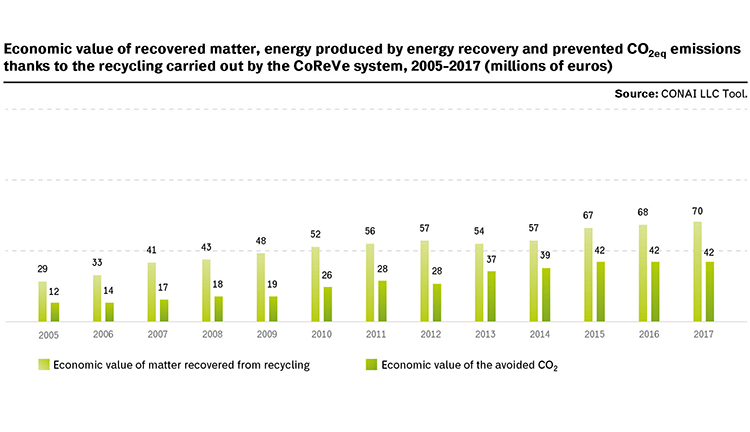During the first 20 years in which the consortium was active, the amounts of glass packaging released for consumption increased by 27.6% (from 1,905,000 in 1998 to 2,430,000 in 2017), the quantity of collected waste increased by 149% and recycling by 139%. The recycling rate went from 36.8% in 1998 to 72.8% in 2017. Today, the amount of glass packaging waste collected is 33.3 kilograms per inhabitant, 41.7 kg/inhabitant in Northern Italy, 30.1 in Central Italy and 24.0 in Southern Italy. The amount of waste deriving from separate collection in 2017 was 2,019,000, the amount of this waste that was recycled was 1,769 kt (87.6%). These figures are worse than those registered in 2016 (90.5%), partly due to the stocked “raw scraps” that were not processed and recycled during that year, but most of all because of the lower quality of collected material. In fact, the increase in quantity seen in the last few years went hand in hand with a progressive deterioration of the average results of separate waste collection. This is partly caused by the experience curve of regions who adhered to this procedure later, and in part by the rules given by municipalities regarding separate waste collection that are not propaedeutic to recycling.
There have been a few critical issues in the course of the years. We must underline a lack of territorial homogeneity. CoReVe had to tackle various levels of development of separate waste collection since the very beginning, and some of them are still present today, even though there have been extraordinary improvements. In fact, the average per capita output in 1998 in Northern Italy was 22 Kg/inhabitant, 11.4 in Central Italy and just 2.2 in Southern Italy. The rate of separate waste collection has grown by 82,8% in the north, 164% in the centre and 991% in the south. These results were obtained thanks to the numerous promotion and communication campaigns that were mainly focused on Southern Italy. These campaigns were carried out as regional road-shows in order to involve public administrators, regional technical boards with representatives from municipalities and waste collection management, co-financings for the purchase of containers suitable for the separate collection of glass, extraordinary incentives for the increase of waste collection in southern regions and finally local communication activities, oriented towards quantity increase. Great national and local efforts were made in order to improve consumer habits towards a more careful separate waste collection, allowing the collection of more recycling-oriented material. We carried out five publicity campaigns on national television on the most important generalist networks, with Mario Tozzi and Licia Colò as testimonials, and in agreement with ANCI, in order to underline the fact that crystal, ceramic and pyrex (the most present and insidious polluting substances) must be considered as mixed waste. Market analyses carried out by Astra Ricerche show that citizens who erroneously mix crystal and glass when separating waste went from 44,5% in 2010 to 18.2% in 2017, the mistakes for ceramic dropped from 9.6% to 7.9%, and those relative to pyrex from 23.2% to 9.5%.
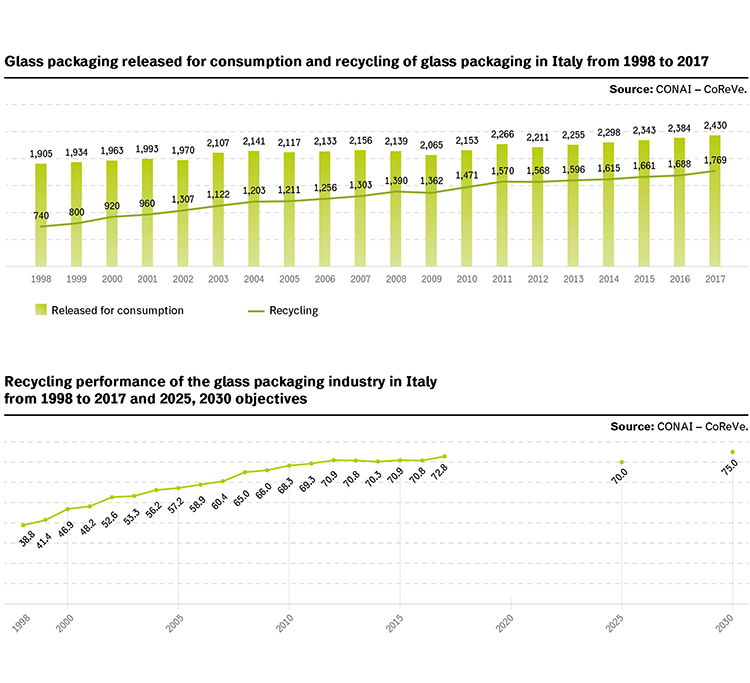
CoReVe carried out a specific research on ceramic in 2015, in collaboration with important managers from northern, central and southern Italy. Said research underlined the fact that glass packaging waste from cafes and restaurants contains 2.5 times more ceramic than household waste. Therefore, we gave way to the “Horeca Project” in 2016, in collaboration with FIPE and Federalberghi, in order to inform and raise the awareness of those who operate within these public services on how to properly separate waste for collection. This campaign resulted in a 14.3% reduction of the presence of infusible waste in the total collected material. The analysis carried out after the campaign specifically located the profile of businesses with a higher rate of mistakes: these are mostly small restaurants-cafes in the central areas of medium and large sized cities, with few employees and a high number of quick meals in the central hours of the day. We will dedicate specific activities to said businesses in the future.
Another important activity carried out by CoReve regards scientific research executed by the Experimental Glass Station ordered by the Consortium, that was economically supported by CONAI in the past. Its objective is to improve the control methods of recovered material, increase recycling of all glass fractions of collected waste, even very small particles, and try to find opportunities to reduce the amount of processing waste in the recovery process, which is currently sent to landfills.
The numerous activities carried out by the Consortium contributed to the progressive growth of recycling performances registered in the last twenty years, as we stated earlier: less than 40% of the material released for consumption was recycled in 1998, whilst in 2017 the amount of recycled glass packaging waste was 72.8%. Naturally, this growth will continue with the increasing decisiveness of the Consortium’s activities, even though current recycling performances are already beyond the targets set by the new European directives for 2025, and are already very close to the objectives set for 2030.
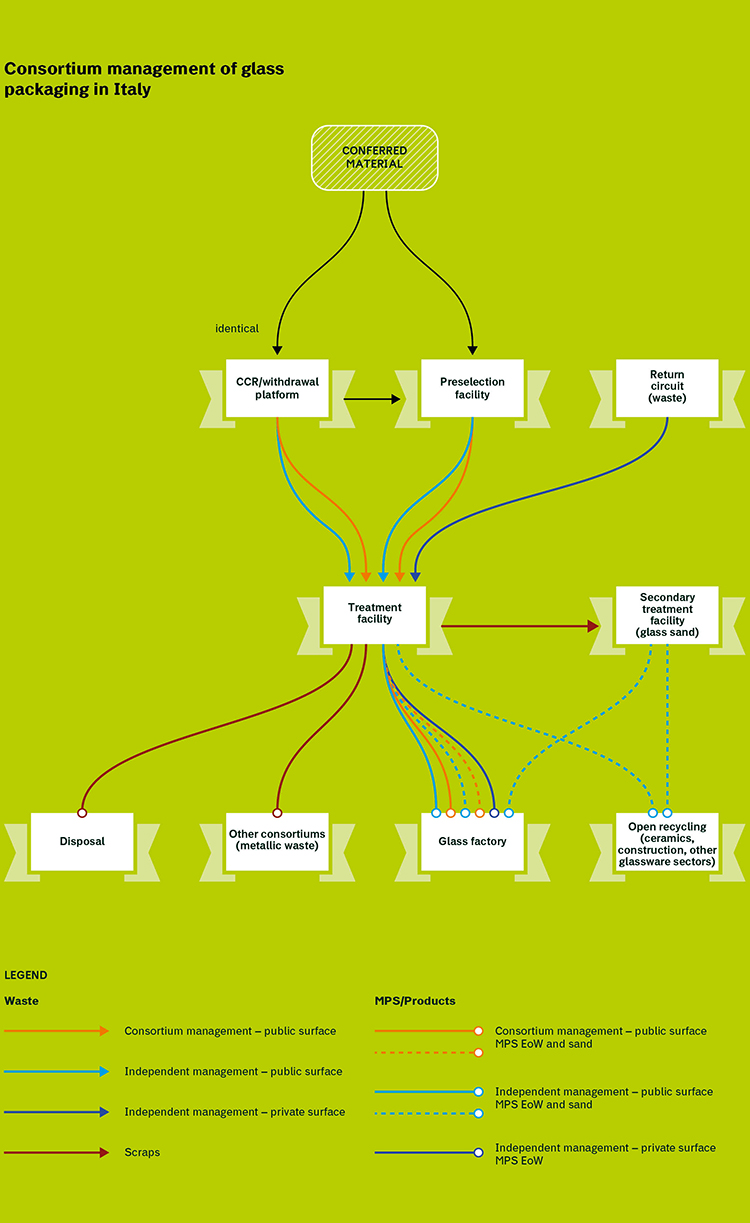
Environmental and socio-cultural benefits of consortium management
The CoReVe system, tough operating in a subsidiary position with respect to the market, recycled 1,426,000 tons of glass waste in 2017, 81% of all the glass waste recycled in Italy, including independent waste management.
The amount of waste recycled between 2005 and 2017 has more than doubled (approximately +140%) due to the transfer from independent management and, most of all, because of the evolution of waste collection, promoted by CoReVe.
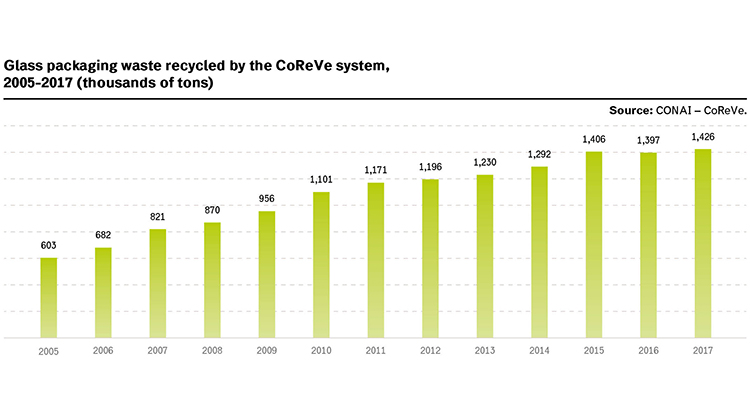
The substitution rate for glass produced with MPS in the LCC Tool is estimated based on a 1:1 ratio, i.e. with one kilogram of recycled glass replacing exactly the same amount of MPS (“Matgeria Prima Seconda”, Secondary Row Materials) used in the previous cycle, avoiding the use of mixtures of virgin raw materials that would have a 1.17:1 ratio. Therefore, it is clear why 1,668,000 tons of virgin raw material was saved in 2017.
The environmental benefits were extremely high. Recycled glass waste as a secondary raw material has replaced 16.4 million tonnes of a mixture made primarily of silica sand and soda between 2005 and 2017, it prevented the emission of 12 million tons of carbon dioxide and saved fossil energy and electricity for a total of 55 million MWh.
The energy saved from the recycling of glass packaging managed by CoReVe in 2017 was equal to 5.6 million MWh of equivalent primary energy, practically the same as 2016.
The trend for saved energy and avoided emission have shown a steady development in the last few years.
In fact, between 2005 and 2017:
- Saved MWh thanks to recycling have more than doubled;
- Emissions avoided thanks to recycling have tripled.
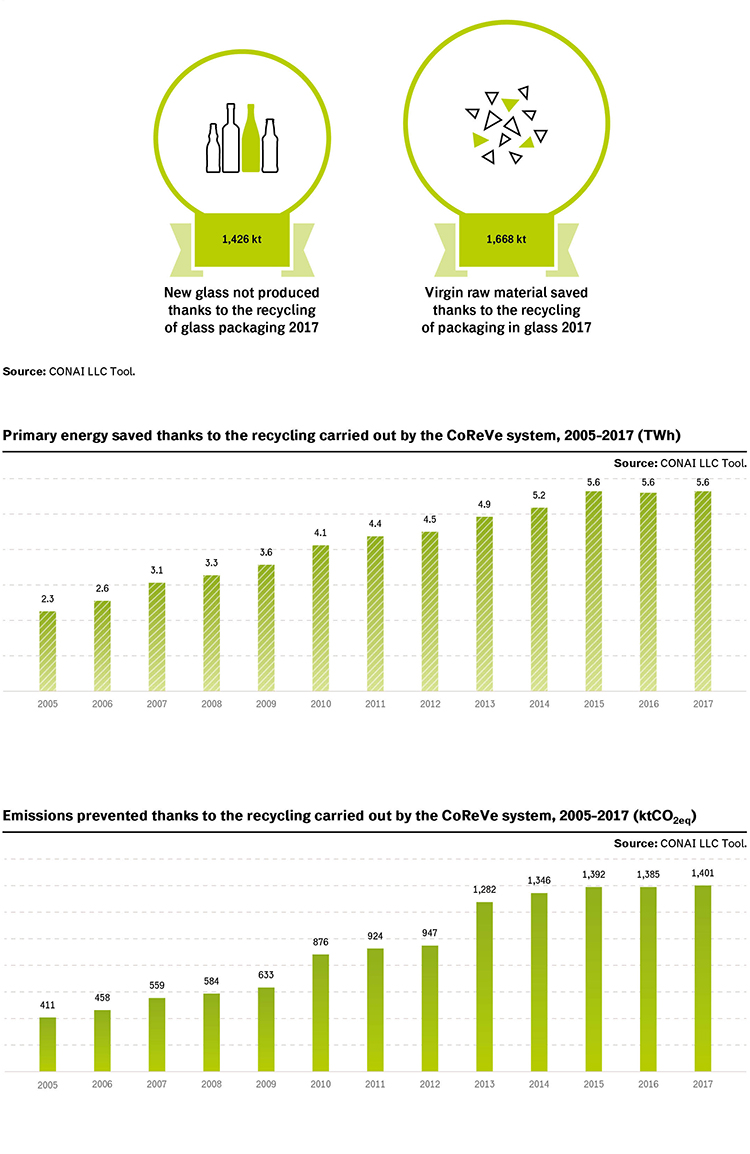
The environmental benefits we have listed above allow us to determine the correlated economic benefits for the country system, directly and indirectly generated by the activities carried out by the consortium.
We can estimate that on the whole, the consortium glass packaging waste collection industry has generated an economic value beyond one billion euros between 2005 and 2017.
It consists of:
- 675 million euros of direct benefits generated by the consortium glass packaging recycling industry, represented by the economic value of saved raw material; such benefits were equal to 70 million euros in 2017 alone (more than twice the estimated value for 2005);
- 364 million euros of indirect benefits that refer to avoided CO2eq thanks to the recycling activities carried out by consortium management; the total for 2017 is 42 million euros (more than three times the value estimated for 2005).
We must also add the significant benefits of prevented primary energy consumption: an economic valuation method for these factors is currently being developed.
